SEED TIME
Late this Year
This year I’m late, but not too late, with my seed orders. Usually, I get them in by a couple of weeks ago.
The only seeds that I’ll soon be planting are those of lettuce, arugula, mustard, and dwarf pak choy. They’ll fill any bare spaces soon to be opening up where winter greens have been harvested. No rush, though, because I have seeds left over from last and previous years of these vegetables, and they keep well if stored under good conditions.
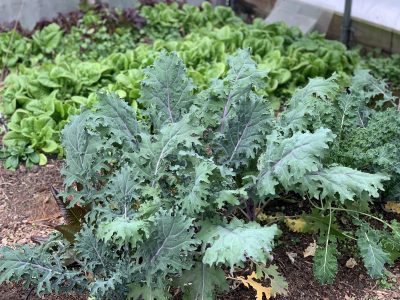
I’ve usually sowed onion seeds early also, in flats in the greenhouse in order to give plants enough time to become large transplants. Large transplants translates to large plants out in the garden before long days force them to shift from growing leaves to, instead, swelling their bulbs. More leaves before that shift makes for larger bulbs.
Last year, because of poor onion germination in the flats, I ended up getting fresh seeds and sowing them directly in the garden in early spring. Keeping the bed moist promoted quick germination and, by August, the bulbs stood up well, size-wise, to those from seeds sown in the greenhouse in past Februarys.
Seed Longevity
Onion and leek seeds don’t keep very well. Viable seeds are living, albeit dormant, embryonic plants which do not live forever. Conditions that slow biological and chemical reactions, such as low temperature, low humidity, and low oxygen, also slow the aging of seeds.
Seeds differ in how long they remain viable. Except under the very best storage conditions, it’s not worth the risk to sow onion, parsnip, or salsify seeds after they are more than a year old. Two years of sowings can be expected from seed packets of carrot and sweet corn; three years from peas and beans, peppers, radishes, and beets; and four or five years from cabbage, broccoli, Brussels sprouts, cucumbers, melons, and lettuce.
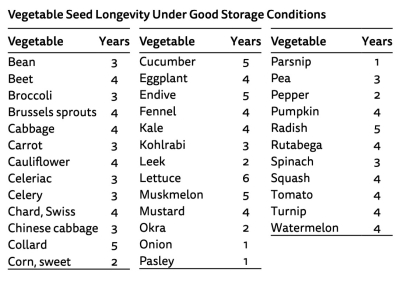
Among flower seeds, the shortest-lived are delphinium, aster, candytuft, and phlox. In general, though, most annual flower seeds are good for one to three years, and most perennial flower seeds for two to four years.
In a frugal mood, I might do a germination test for a definitive measure of whether an old seed packet is worth saving. Counting out 10 to 20 seeds from each packet to be tested, I spread them between two moist paper towels on a plate. Another plate inverted over the first plate seals in moisture and the whole setup then goes where the temperature is warm, around 75 degrees.
After one to two weeks, I peel apart the paper towels and count the number of seeds with little white root “tails”. If the percentage is low, the seed packet from which the seeds came gets tossed into the compost pile. (I don’t give them away!). Or, I might use the seeds and adjust their sowing rate accordingly.
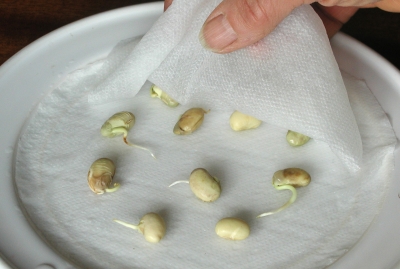
No one knows exactly what happens within a seed to make it lose its viability. Besides lack of germination, old seeds undergo a slight change of color, lose their luster, and show decreased resistance to fungal infections. There’s more leakage of substances from dead seeds than from young, fresh seeds, so perhaps aging influences the integrity of the cell membranes. Or, since old seeds are less metabolically active than young seeds, the old seeds leak metabolites that they cannot use.
Finally, Get My Orders In
Today I dug out my shoeboxes of seeds from the unheated workshop and noted what was missing and what was too old.
Needed still are yet undetermined, good varieties of Brussels sprouts, celeriac, semi-hot pepper, and melon. (Any suggestions for good varieties?) Also one or more packets of Bartolo cabbage, Blues Michili cabbage, Shintokiwa cucumber, Golden Bantam 8-row sweet corn, Blacktail Mountain watermelon, Carmen pepper, Mammoth sunflower, and Empress of India nasturtium.
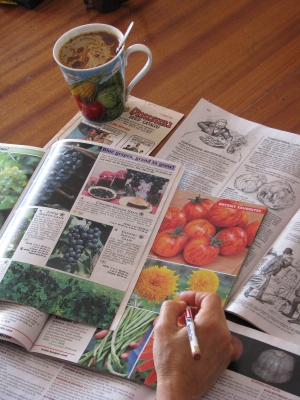
And, of course, some tomato varieties need replenishment: Sungold, Anna Russian, Nepal, Carmello, San Marzano, and Amish Paste. They will join Belgian Giant, Pink Brandywine, Paul Robeson, and Blue Beech out in the garden.
A colorful and flavorful growing season is in the offing.

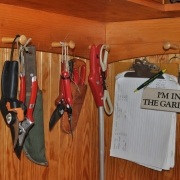

Thanks for the reminder to do the annual seed inventory and ordering, Lee. I absolutely loved growing and eating the “lambkin” piel de sapo melon last year…
I’ve tasted piel de sapo from the market and it was delicious. I haven’t grown it yet, though.
We like gustus brussels sprouts.
We did also except the sprouts were not quite big and firm enough.
I have had very good luck with Hestia Brussels Sprouts from Fedco for a few years now. Red Rubine needs a longer season here in zone 4b in the Daks. I am trying Long Island Improved this year as well.
I am trying my hand at wintersowing some of my old flower seed and will report back as to how it goes!
I’ve tried Hestia and Gustus from Fedco. They seemed okay. Perhaps I have to grow them better (more compost?, more staking?), no matter what the variety.
I had better luck with Hestia, spacing them a full 2 feet and if need be, staking them (I use old tomato cages for those as well as for my favas).
Tomato cages, good idea. A lot easier that staking.
I really like Charentais melons. Got my original seeds from Sow True Seed. I also grow Cinderella pumpkins and Styrian Hulless pumpkins (for the seeds) which I also got from them.
That’s interesting to hear about the onion seeds. I may have to try direct sowing this year. Depending on your definition of semi-hot, jaluvan attitude from Fedco is a great not-quite-a-jalapeño for cooler climates. Especially good when allowed to ripen to red.
Thanks for the feedback but the Scoville rating for this pepper is the same as for jalapeno. Of course, growing conditions also affect the heat. I like something not quite so hot.
I grew hestia, red ball, long island improved, and darkmar 21 (adaptive seeds). The Hestia I liked the best, but didn’t realize that the sprouts would be rather small. They had good flavor and yielded well. The long island didn’t make budded sprouts but rather small leaves not tightly bound (still ate them, but it struck me as too similar to growing kale. The darkmar took a long time to mature, and they make kind of a loose savoyed sprout, small but very good flavor, interesting texture, and pretty emerald green color. The red ball made one giant brussels shaped cabbage at the top of the plant… I ate it but I wasn’t looking to grow cabbage so that was annoying. Perhaps the name of the variety should have been an indicator? I will do the Hestia and darkmar again and select a new type to try, since these both yielded sprouts that were rather small.
Give Gustus a try also. It wasn’t perfect but was pretty good.
JADE CROSS is the only Brussel Sprout I grow here in AK where my season is short. Have tried many others but JC is always a consistent producer